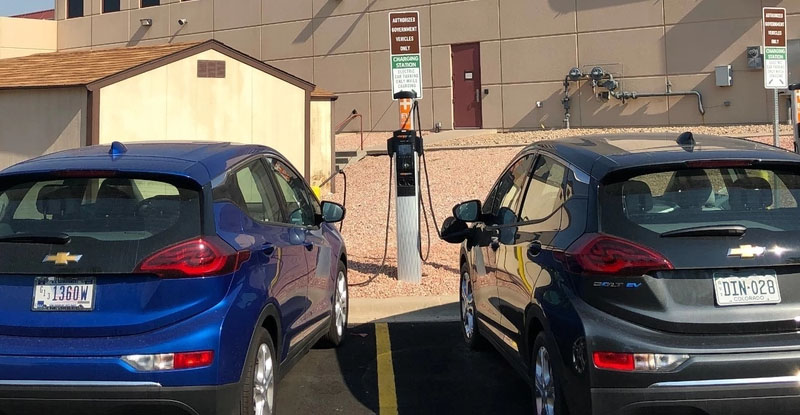The Department of Defense has mandated all military branches to convert their fleets of non-combat vehicles from gas powered to electric by 2035.
That gives each installation across the country a little more than a decade to figure out the logistics of buying the vehicles and having enough places to charge them.
Fort Leonard Wood in Missouri’s Ozarks has found a way to try to make it work. It has transferred to the local electric utility the responsibility of building, maintaining, and updating the rapidly changing technology needed at charging stations.
There are more than 700 government owned non-tactical vehicles on post at Fort Leonard Wood, and work is underway to make all of them electric vehicles over the next dozen years. So far there are only seven, but 36 more are on the way.
Buying the vehicles is one thing, but having enough places on the 100 square mile post to charge them is another. The charging requirements for vehicles are changing as technology advances.
Installing enough chargers cost effectively without sinking money into something that could be obsolete in a few years is a major challenge. . . . (read more at KPBS)
Fort Leonard Wood prepares for arrival of electric vehicles (DOD, 4 AUG 22)
. . . Government-owned vehicles are going electric as well — Fort Leonard Wood received two EVs last month, and more are on the way. The electric vans in the Logistic Readiness Center inventory are part of the Army’s latest directive of electrifying its non-tactical vehicle fleet. Executive Order 14057 — Catalyzing Clean Energy Industries and Jobs Through Federal Sustainability — requires the Department of Defense to transition its non-tactical vehicles to a 100% zero-emission vehicle fleet, including 100% of light-duty acquisitions by 2027, and 100% of medium- and heavy-duty acquisitions by 2035. Fort Leonard Wood maintains approximately 540 vehicles that meet the definition of non-tactical, and the Directorate of Public Works — or DPW — is working out ways to keep those vehicles charged up and ready for use every day. . . .
Guard Charges Forward with Electric Vehicle Conversion (DOD, 25 JAN 23)
…..The National Guard is taking strides to meet White House climate and energy initiatives by updating its fleet of about 13,000 non-tactical vehicles to hybrid or electric in the next four years and tactical vehicles by 2035. According to Guard officials, this would cut roughly 30-50% of fuel costs. “All of our influence on the overall climate strategy is important, and it is important to be a part of the solution and not be a part of the problem,” said Col. Timothy Wood, NGB logistics officer. “So, we move forward, not just because it’s just an executive order, but because it’s the right thing to do and fall in line with our future.” The Guard has moved forward with other White House climate and energy initiatives. According to Guard officials, this includes reducing Army greenhouse gas emissions by 50% by 2030 and achieving net zero greenhouse gas emissions by 2050. . . .
Fort Polk drives into future with solar charging stations, electric cars (DOD, 13 FEB 23)
. . . . The Army’s non-tactical vehicle fleet constitutes approximately 3% of Army greenhouse gas emissions. . . . . Moving to lease and purchase zero-emission NTVs will significantly reduce GHG and support President Joe Biden’s Executive Orders: EO 13990 — Protecting Public Health and the Environment and Restoring Science to Tackle the Climate Crisis and EO 14008 — Tackling the Climate Crisis at Home and Abroad. As directed by U.S. Army Materiel Command, the Fort Polk garrison, in coordination with stakeholders, is preparing mid-range to long-range master plans to transition to electric, NTV in support of the electrification of the government’s fleet. . .
DAF to Pilot Carbon Pollution-Free Electricity across Several Installations (USAF, 15 FEB 23)
The Department of the Air Force acknowledges that unprecedented changes to the global climate and increasingly severe weather events create new challenges for continued mission assurance. As one of the largest energy consumers, the Department of Defense has a unique opportunity to catalyze private sector investment and expand the economy and American industry by transforming how we build, buy, and manage electricity, vehicles, buildings, and other operations. The DAF is participating in a DoD-wide initiative to accelerate the deployment of clean energy and decrease greenhouse gas emissions, while enhancing installation energy resilience. In alignment with Executive Order 14057, “Catalyzing Clean Energy Industries and Jobs Through Federal Sustainability,” the DoD is piloting new electricity procurement approaches to achieve 100% carbon pollution-free electricity by 2030. . . .
DOD, Other Agencies Release Climate Adaptation Progress Reports (DOD, 6 OCT 22)
The Defense Department along with federal agencies across the government released its 2022 Climate Adaptation Plan Progress Report. Executive Order 14008, Tackling the Climate Crisis at Home and Abroad and Executive Order 14057 Catalyzing Clean Energy Industries and Jobs Through Federal Sustainability, requires that each federal agency develop, climate adaptation plans, better known as CAPs, and annual progress reports to communicate agency action to bolster climate adaptation and resilience. DOD has identified climate change as a critical national security issue. . . . . DOD is incorporating climate change into education and training programs across the military and civilian workforce. . . .
Biden Proposal Puts Climate Agenda Above America’s Defense (Heritage Foundation, 22 FEB 23)
. . . . The FAR Rule risks turning defense contractors into just another tool of climate activists. The new regulation places the Department of Defense’s basic mission of national security second to climate change. Rather than helping arm America against growing threats from China, the rule requires major contractors to count their level of greenhouse gas emissions like carbon dioxide and develop a plan to comply with the Paris climate accords.
This follows a pattern of politicization of our national defense.
Does anyone care how much carbon dioxide was emitted when the F-22 fighter jet engaged a foreign object and shot it down with a Sidewinder missile?
The FAR Rule doesn’t just put America’s defense in second place, it actively takes money away from defense priorities. The proposed rule is estimated to cost $3.9 billion in compliance over a 10-year period. That amount could buy an aircraft carrier or 42 F-35 fighter jets.
Second, the new rulemaking is entirely optional. Congress never passed a greenhouse gas emissions reduction mandate; and the Paris Agreement, although signed by President Barack Obama and reinstated by President Joe Biden, does not carry the weight of an international treaty because it was not ratified by the Senate.
So why implement this regulation? The administration says the rule is meant to comply with Executive Order 14030, issued in 2021, which attempts to establish a goal of “net zero” greenhouse gas emissions, at least for the federal government. However, there’s no law that compels the Department of Defense or any other agency to move forward with these regulations. . . . . [Yet the do and act as if it were law]








Leave a Comment